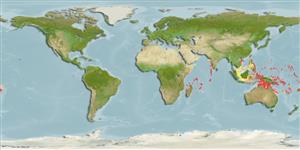Common names from other countries
Environment: milieu / climate zone / depth range / distribution range
Ecología
marino asociado a arrecife; rango de profundidad 1 - 55 m (Ref. 27115), usually 1 - 35 m (Ref. 90102). Tropical; 22°C - 28°C (Ref. 27115); 19°N - 22°S
Indo-Pacific: Aldabra and Astove of Seychelles to the Loyalty Islands, Fiji and Japan. Report from southern Marshall Islands appears to be based on the paratype of Luzonichthys robustus Fourmanoir, which has been reidentified as Luzonichthys earlei (Ref. 8524).
Tamaño / Peso / Age
Maturity: Lm ? range ? - ? cm
Max length : 7.0 cm TL macho / no sexado; (Ref. 2334)
Espinas dorsales (total) : 10; Radios blandos dorsales (total) : 15 - 16; Espinas anales: 3; Radios blandos anales: 7. Looks blue with dark yellow over the back when seen in natural light. Unlike most other basslets, the dorsal fins are in two parts (Ref. 48635).
Usually in groups on outer reef slopes (Ref. 27115). Most commonly occurs in shallow water and most likely seen by divers (Ref. 37816). Forms dense aggregations that feed on zooplankton (Ref 90102).
Life cycle and mating behavior
Maturities | Reproducción | Spawnings | Egg(s) | Fecundities | Larva
Randall, J.E. and J.E. McCosker, 1992. Revision of the fish genus Luzonichthys (Perciformes: Serranidae: Anthiinae), with descriptions of two new species. Indo-Pac. Fish. (21):21 p. (Ref. 8524)
IUCN Red List Status (Ref. 130435)
CITES (Ref. 128078)
Not Evaluated
Threat to humans
Harmless
Human uses
Pesquerías: comercial; Acuario: Comercial
Herramientas
Special reports
Download XML
Fuentes de Internet
Estimates based on models
Preferred temperature (Ref.
115969): 25.9 - 28.9, mean 27.7 (based on 604 cells).
Phylogenetic diversity index (Ref.
82804): PD
50 = 0.5156 [Uniqueness, from 0.5 = low to 2.0 = high].
Nivel trófico (Ref.
69278): 3.4 ±0.45 se; based on food items.
Resiliencia (Ref.
120179): Alto, población duplicada en un tiempo mínimo inferior a 15 meses (Preliminary K or Fecundity.).
Fishing Vulnerability (Ref.
59153): Low vulnerability (10 of 100).
